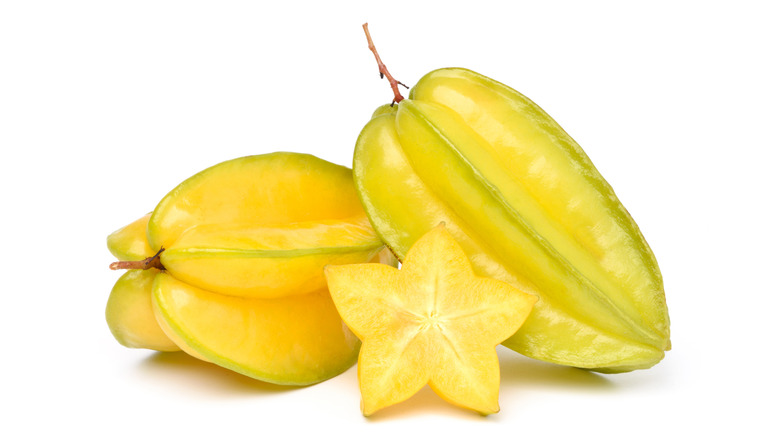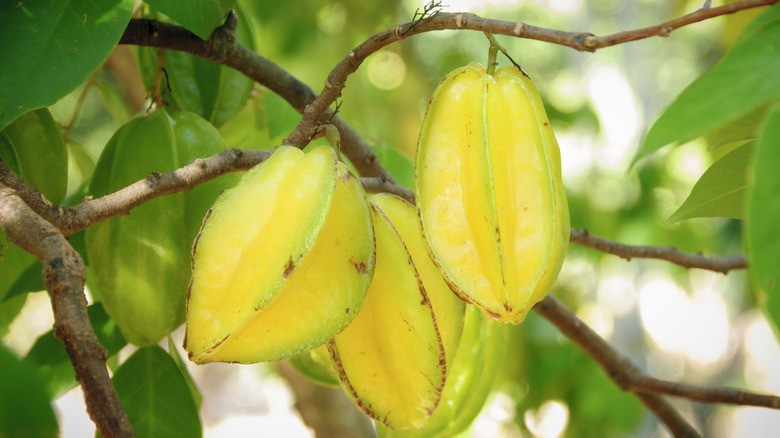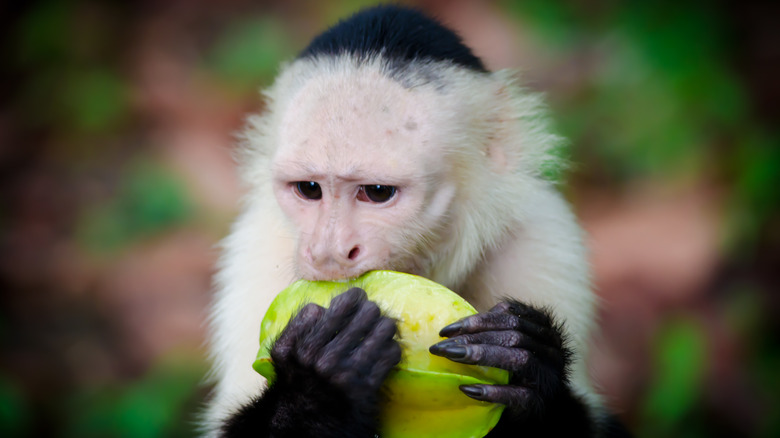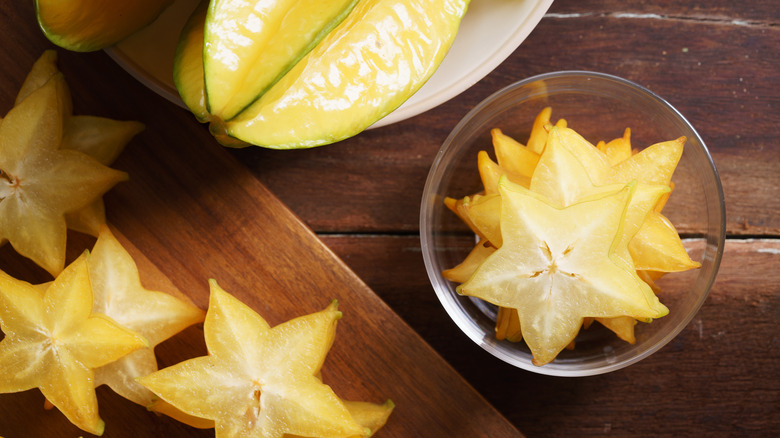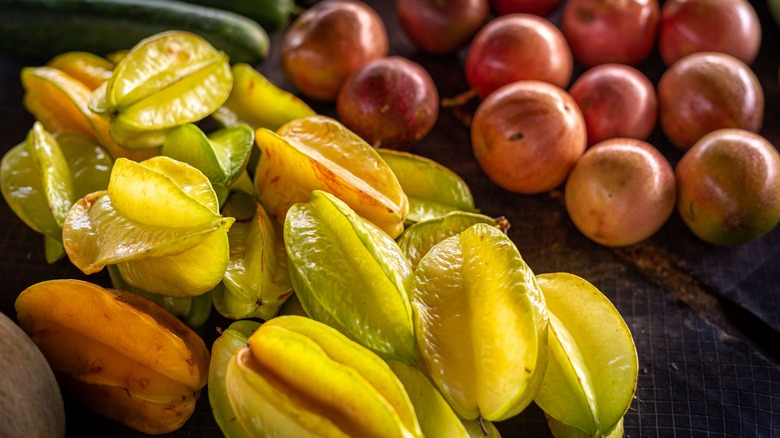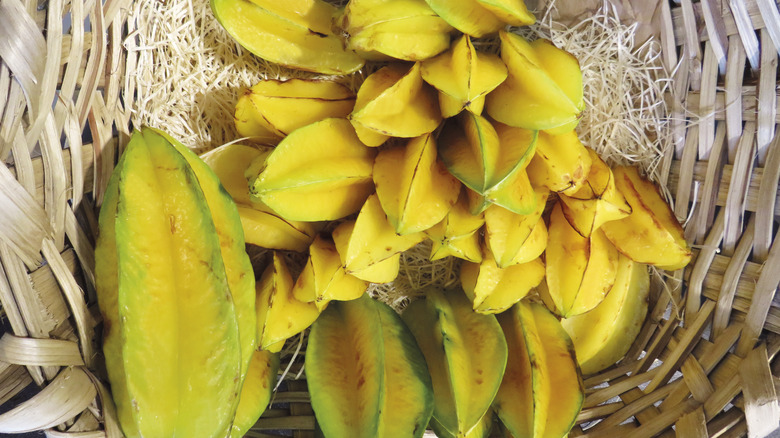What Is A Star Fruit And How Do You Eat It?
As nature's perfect little pentagon, the star fruit (Averrhoa carambola) belongs in the exotic fruit hall of fame. Keeping company with the likes of dragon fruit, jackfruit, prickly pear, and the rambutan, this mellow-yellow beauty seems almost too pretty to eat — but please do so. It's a taste you're unlikely to forget, and it dazzles up your dining table just by sitting there.
Named for the striking star shape emerging from the cut fresh fruit, this vibrant tropical anomaly is a global favorite. Also known interchangeably as carambola, it maintains a cultivated presence in the U.S. states of Florida and Hawaii, with online tropical fruit purveyors offering delivery, sometimes with free shipping.
Star fruits often serve as finger fruits, get blended into smoothies, or appear as garnishes for salads and cocktails — but regional customs and recipes extend much further. This guide digs a little deeper into what a star fruit is, how it tastes, where to find them, ideas for eating them, and all the nutrients packed into those chubby little stars.
What is a star fruit?
Star fruits grow on stubby-trunked evergreens in the extended Oxalidaceae family, originating in countries such as the Philippines, India, Indonesia, Malaysia, Vietnam, and Sri Lanka. They've roamed about over the centuries, adapted by cultivators across the globe and in the U.S. states of Florida and Hawaii. It answers to other names based on location, including carambola in Spanish-speaking locales, carambolier in France, belimbing in Indonesia, five corner fruit in Australia, and five finger fruit in the South American country of Guyana.
The unusual exterior of a star fruit gives rise to the namesake shape that emerges after it's cut. Oblong and measuring roughly three to six inches long and 3.5 inches wide, each fruit sports five attached "wings" with thin green edging. Cutting horizontally across all five protruding wings results in stunningly accurate five-point star shapes. You can eat the entire fruit, including the waxy skin, juicy flesh, and tiny brown interior seeds — but you might want to forego the latter.
What does a star fruit taste like?
Unless making jam or a tangy sauce, you'll want to avoid immature star fruitssince an inherently sour taste remains until they're ripe. But once that happens, the inner flesh turns lusciously succulent with a mild balance of sweet and tart flavors. Some compare the taste to plums, grapes, pears, oranges, apples, or a nuanced mixture of similar fruits.
Nestled within that heady tropical aroma and juicy yellow flesh are up to a dozen tiny flat seeds. They are entirely edible but tend to be bitter, sour, or overly citrus-centric. After cutting the fruit into star shapes, you'll find the seeds in the center of the slices. It's easy to remove them with your fingers or the tip of a knife.
For the best flavor, look for star fruits that are almost entirely bright yellow, with minimal bits of green, particularly on the wing tips. Avoid ones with deeper yellow tones or brown spots, as this indicates an over-ripe piece of fruit with potentially mushy texture.
How to eat star fruits
As with many fruits, the easiest way to eat a carambola, aka star fruit, is to take a bite right through the skin, no peeling necessary. If you've chosen to slice it into perky star bites, just pop one in your mouth and enjoy it in its natural form — raw and unadorned.
Before cutting a star fruit, thoroughly wash the exterior, which is good practice with all fruits and vegetables. Some tropical-fruit aficionados suggest trimming off the green or sometimes-brown edging of each of the five wings since it may be less flavorful than the flesh. Slice off both ends of the fruit, lay it horizontally on its side and slice to your desired thickness. About half an inch will give sturdy star-shaped chunks of fruit for easy handling.
Eating raw star fruit is easy and delicious, but that's far from your only option. They perk up smoothies, fresh-squeezed tropical fruit-juice mixtures, or cocktails, including a Spanish-style wine-and-fruit sangria. The fanciful star shape works well as a drink garnish and adds intrigue to salads or fruit-cocktail desserts. You also bake them into tarts and pies or make a Malaysian-style bowl of stewed carambolas, apples, cloves, and sugar or honey.
Marinades get a sweet touch from ripe star fruits, while chutneys, jams, and relishes benefit from the extra tang of under-ripe star fruits. Try making a sauce to accompany poultry or seafood, such as a carambola sauce with scallops.
Where to buy star fruits
Finding star fruits is easier in countries where they grow prolifically or in specific regions or states. They'll be more abundant and tasty in Florida and Hawaii during the in-season months of roughly June through February. You'll find them in some mainstream grocery stores but more commonly at farmers' markets or from growers with onsite farm stands.
However, shopping online widens availability, with specialty fruit sellers providing access to star fruits from various tropical growing regions. Online vendors typically sell carambolas by the pound in predetermined box sizes, such as small samplers or others ranging from five to 12 pounds. Some companies even allow you to mix and match with other available fruits to meet box quantities for free or reduced shipping. Fruit subscription boxes reduce the price even further, keeping you in fruity heaven throughout the seasons.
When purchasing carambolas, keep in mind that two basic types exist. The cultivated sweet variety is almost always what you'll find from sellers and grocery outlets. But there's a smaller wild variety that's greener, more sour, and sometimes irregularly shaped. You want to avoid these, for the taste and potential health issues affecting some people.
Nutritional information about star fruits
Then there's the nutrition aspect of these little starry gems. In addition to being adorable, they also hold their weight in the health category, harboring loads of dietary fiber and vitamin C, as well as B5, folate, and minerals such as iron, magnesium, and potassium. Healthline notes that star fruits also hold healthy plant compounds with impressive amounts of antioxidants, potentially leading to notable health benefits.
Though conducted with animals rather than humans, ongoing studies reveal possibilities for star-fruit compounds to aid in lowering inflammation and cholesterol, and reducing risks for fatty liver disease. However, it's important to note the presence of oxalate and caramboxin in carambola fruits, which can present issues for those with kidney disease, according to Bioinformation. This is particularly true with the wild, uncultivated type of star fruits that contain more oxalate. Anyone taking prescription medications should also consult with a physician about the star fruit compounds potentially changing how medications break down within the human body.
In the world of alternative medicine, practitioners in Ayurvedic and Traditional Chinese Medicines (TCM) have advocated eating carambola/star fruits for conditions such as headache, cough, and fever relief, as well as issues such as skin inflammation, gastroenteritis, and ringworm.

